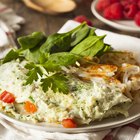IriGri8/iStock/GettyImages
Making homemade lasagna isn't difficult, but it does require several steps and a few dirty pans. If you plan on freezing the lasagna to have a quick meal on hand for busy nights, it tastes freshest if you freeze it unbaked. You can safely use raw eggs in a frozen lasagna as long as you cook the lasagna thoroughly before you serve it.
Egg Safety
Raw eggs can carry harmful bacteria, such as salmonella, but freezing a lasagna that contains raw eggs is safe if you follow proper freezing and cooking procedures. When the lasagna is frozen at 0 degrees Fahrenheit, bacterial growth is temporarily suspended. The bacteria begin to grow again once the lasagna is thawed. So long as you cook the lasagna to an internal temperature of 160 F, any bacteria in the raw eggs will be destroyed. The USDA recommends reheating frozen prepared foods to a temperature of 165 F.
Quality Assurance
Raw eggs and ricotta cheese both have a reputation for being difficult to freeze. Raw eggs may become rubbery after being frozen and ricotta cheese may separate and become watery. However, these problems are most obvious in foods where the eggs and cheese play a starring role. Combining eggs and cheese with other ingredients stabilizes them and makes any changes in texture less apparent. Properly package and freeze the lasagna and you'll be happy with the results. Another option is to use a pasteurized egg product in the lasagna. These products have been cooked at low temperatures, which helps stabilize them and destroys any bacteria present.
Freezing Lasagna
When cooking a lasagna that you plan to freeze, cook the noodles for a bit less time than you normally would. Freezing causes them to soften and they'll soften further when you reheat the dish. Another option is to use oven-ready lasagna noodles that don't require cooking. Add a bit more water to your sauce if you use oven-ready noodles. Combine the raw eggs thoroughly with other filling ingredients, such as ricotta cheese and seasonings. To freeze a lasagna, place the lasagna in a freezer-proof baking dish or in a disposable aluminum pan. Cover it tightly with aluminum foil and write the date, the name of the dish and any reheating instructions on the foil with marker. Freeze the lasagna at 0 F for up to four months.
Baking a Lasagna
You've got two options when it's time to cook the lasagna. You can thaw the lasagna covered overnight in a refrigerator set at 40 F. Preheat the oven to 375 F and bake the lasagna for 35 to 45 minutes, or until the cheese is bubbly and brown and a thermometer inserted in the middle registers 165 F, which eliminates any worry about raw egg safety. You can also bake the lasagna without thawing it, but you'll need to double the cooking time. In both cases, bake the lasagna covered until it's completely cooked through. Remove the foil to brown the cheese.
Related Articles
Can You Freeze Eggplant Parmesan After ...
Can Lasagna Be Preassembled With Egg As ...

How to Freeze Cheeses

Can You Make Chicken Fettuccine Alfredo ...
Can Swedish Meatballs Be Frozen Until ...

How Long Can You Refrigerate Nacho ...

How to Prevent Cheese Separation in ...

How to Reheat Lasagna

How to Cook an Egg White Omelet in the ...
Baking Quiche the Day Before the Party

How to Use Ricotta Cheese for Cream ...
A Substitute for Meringue

Can You Eat an Egg That's Been Frozen?

Do You Thaw Frozen Cheese Before ...

How to Heat Lasagna From the Fridge

Can You Freeze Casseroles With ...
Can You Thaw & Refreeze Clams?

Freezing a Moussaka

Can I Prepare Baked Brie Ahead of Time?

How to Defrost Frozen Mozzarella
References
Writer Bio
Julie Christensen is a food writer, caterer, and mom-chef. She's the creator of MarmaladeMom.org, dedicated to family fun and delicious food, and released a book titled "More Than Pot Roast: Fast, Fresh Slow Cooker Recipes."